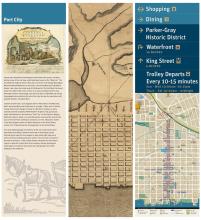Wayfinding: Port City
Port City

Historically, Alexandria’s development moved from east to west, and three distinct areas of the city have unofficially been known as the “West End.” The first West End ended at Shuter’s Hill, the current site of the George Washington Masonic National Memorial. In the 1930’s, the second West End extended to Quaker Lane, about two miles west of the Memorial. The final West End moved about four miles further west in 1952, to an area just beyond what is now Beauregard Street. Interestingly, each area has been so identified not only by its geographical proximity to the rest of the city, but also its association with separate families, all named West.
Commerce Street was a rare diagonal street in Alexandria’s first West End, which connected Duke and King Streets at an angle. Further west in Fairfax County, Duke Street changes its name to Little River Turnpike, an early colonial road that originally linked Northern Virginia’s vast agricultural lands with Alexandria, also known as “Port City,” on the Potomac. Wagons filled with tobacco, wheat, corn and other grains traversed this road on their way to the waterfront warehouses and docks. In 1793, Alexandria ranked as the third largest exporter of wheat and grains in the United States, and by 1797, it had become the 7th largest port in the United States.
The short angled passage at Commerce Street was created and named specifically to facilitate commerce and trade in the growing city by eliminating the need for farm wagons to make sharp right angle turns within the city’s existing street grid. Land for the street was conveyed to the town on January 1, 1798, by John Dundas, Abraham Faw and Francis Peyton to allow for construction of the roadway, thereby allowing the large wagons to maintain their speed and make gradual turns while heading to the waterfront.
Where to Find This Sign
In Old Town, mini kiosks are located at designated intersections along King Street, Cameron Street, and the Waterfront to provide an orientation for pedestrians.
This wayfinding sign is located on the south side of King at Fayette Street. (For those taking the King Street Trolley, please check the schedule as times may have changed.)
See all the wayfinding signs on and around King Street.